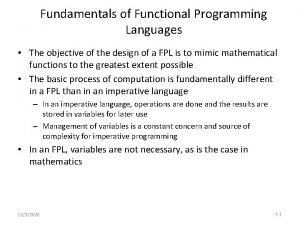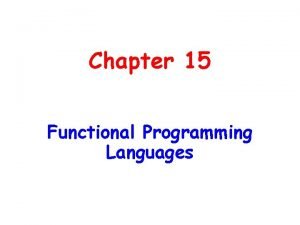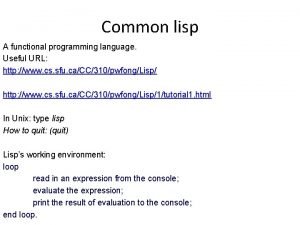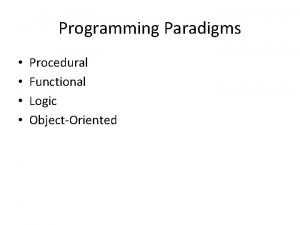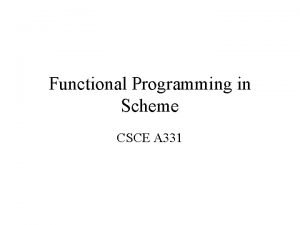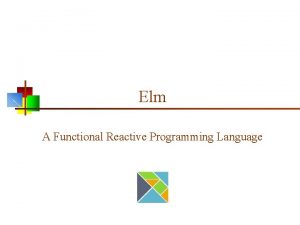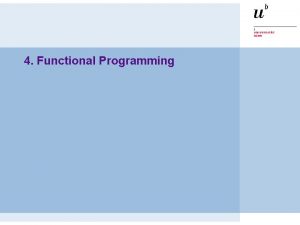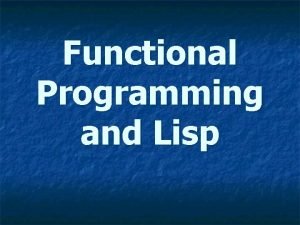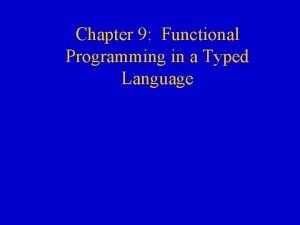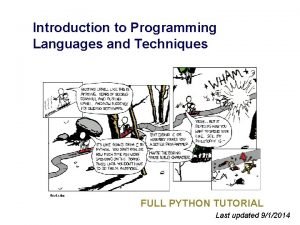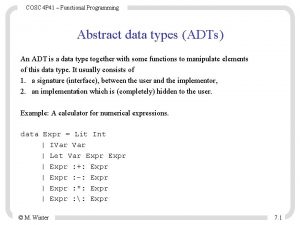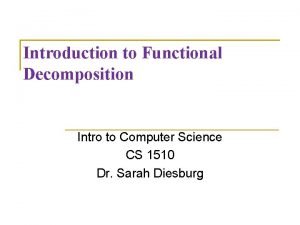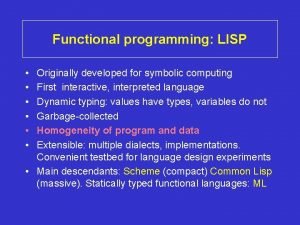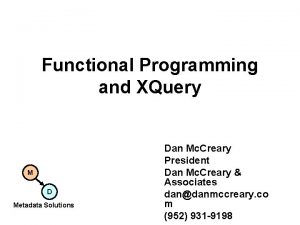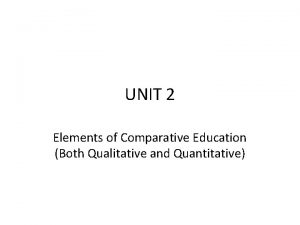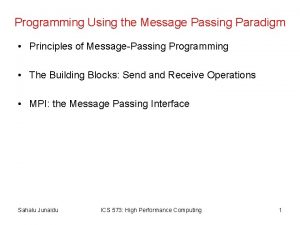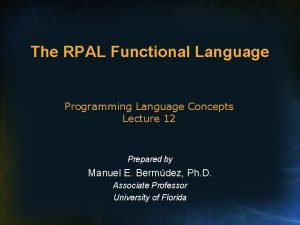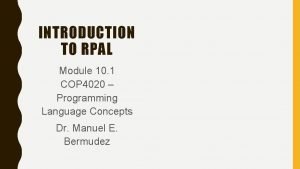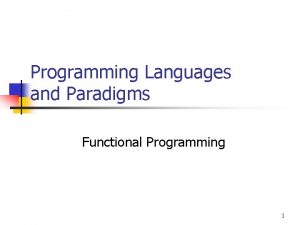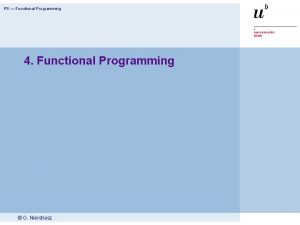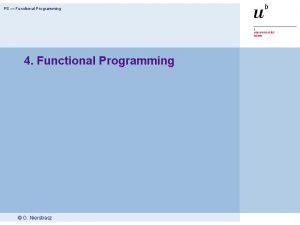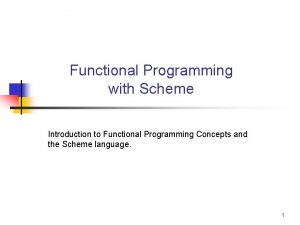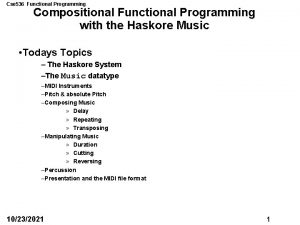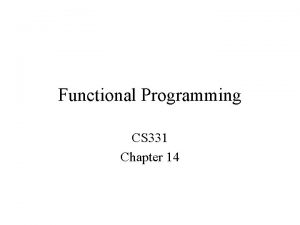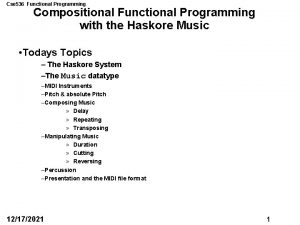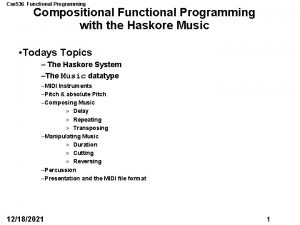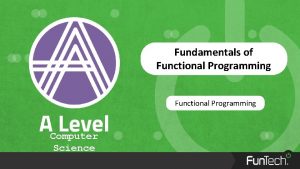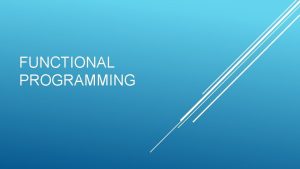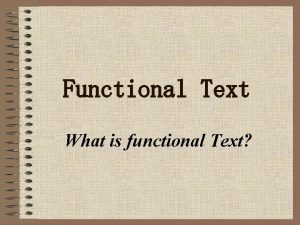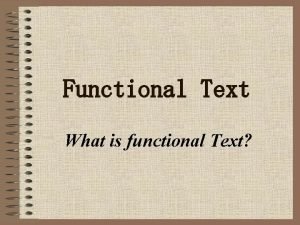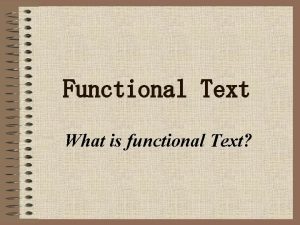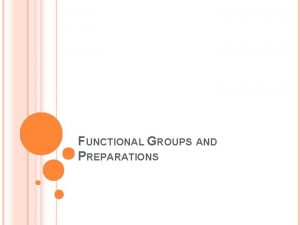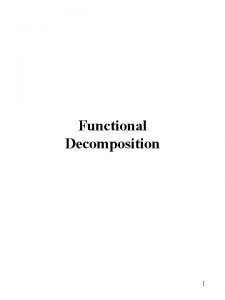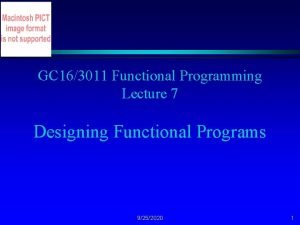The RPAL Functional Language Programming Language Principles Lecture
















































- Slides: 48

The RPAL Functional Language Programming Language Principles Lecture 7 Prepared by Manuel E. Bermúdez, Ph. D. Associate Professor University of Florida

RPAL is a subset of PAL • PAL: ‘Pedagogic Algorithmic Language. • Developed by J. Wozencraft and A. Evans at MIT, early 70's. • Intellectual ancestor of Scheme, designed by Guy Steele, mid-70's. • Steele (Fellow at Sun Microsystems) is also one of principal contributors to Java. • Seach Google: 'Guy Steele Scheme' for some background and perspective.

Why study RPAL? • • Unknown language MUST study the (operational) specs. PARADIGM SHIFT ! Good example of the operational approach to describing semantics. • The other two approaches (more later): • The denotational approach • The axiomatic approach. • Will become our vehicle for denotational descriptions.

Three Versions of PAL: RPAL, LPAL, and JPAL • We will only cover RPAL. • R in RPAL stands for right-reference (as in C). • An RPAL program is simply an expression. • No notion of assignment, or even memory. • No loops, only recursion.

Two Notions: Function Definition and Function Application • RPAL is a functional language. • Every RPAL program is an expression. • Running an RPAL program consists of evaluating the expression. • The most important construct in RPAL is the function.

Two Notions: Function Definition and Function Application (cont’d) • Functions in RPAL are first-class objects. Programmer can do anything with a function: • Send a function as a parameter to a function • Return a function from a function.

Sample RPAL Programs: 1) let X=3 in Print(X, X**2) // Prints (3, 9) The actual value of each program is dummy (the value of Print). 2) let Abs N = N ls 0 -> -N | N in Print(Abs -3) // Prints 3

Preview of Lambda Calculus • Program 1 is equivalent to: (fn X. Print(X, X**2)) 3 • Program 2 is equivalent to: let Abs = fn N. N ls 0 -> -N | N in Print(Abs 3) which is equivalent to: (fn Abs. Print(Abs 3)) (fn N. N ls 0 -> -N | N)

RPAL constructs • • • Operators Function definitions Constant definitions Conditional expressions Function application Recursion

RPAL Is Dynamically Typed • The type of an expression is determined at run - time. • Example: • let Funny = (B -> 1 | 'January')

RPAL Has Six Data Types: • • • Integer Truthvalue (boolean) String Tuple Function Dummy

Type Identification Functions • All are intrinsic functions. • Applied to a value, return true or false: • • • Isinteger x Istruthvalue x Isstring x Istuple x Isfunction x Isdummy x

Other Operations • Truthvalue operations: • or, &, not, eq, ne • Integer operations: • +, -, *, /, **, eq, ne, ls, <, gr, >, le, <=, ge, >= • String operations: • eq, ne, Stem S, Stern S, Conc S T

Examples • let Name = 'Dolly' in Print ('Hello', Name) • let Inc x = x + 1 in Print (Inc x) • let Inc = fn x. x + 1 in Print (Inc x) • Print (Inc 7) where Inc x = x + 1

Nesting Definitions • Nested scopes are as expected. let X = 3 in Scope of X=3 starts here let Sqr X = X**2 in Print (X, Sqr X, Scope of Sqr starts here X * Sqr X, Sqr X ** 2)

Nesting Definitions (cont’d) ( Print (X, Sqr X, X * Sqr X, Sqr X ** 2) where Sqr X = X**2 ) where X = 3 Parentheses required ! Otherwise Sqr X = X**2 where X=3

Simultaneous Definitions let X=3 and Y=5 in Print(X+Y) • Note the and keyword: not a boolean operator (for that we have &). • Both definitions come into scope in the Expression Print(X+Y). • Different from let X=3 in let Y=5 in Print(X+Y)

Function Definitions Within One Another • The scope of a 'within' definition is another definition, not an expression. • Example: let c=3 within f x = x + c in Print(f 3)

Functions • In RPAL, functions are first-class objects. • Functions can be named, passed as parameters, returned from functions, selected using conditional, stored in tuples, etc. • Treated like 'values' (which they are, as we shall see).

Every function in RPAL has: • A bound variable (its parameter) • A body (an expression) • An environment (later) • For example: • fn X. X < 0 -> -X | X

Functions (cont’d) • Naming a Function let Abs = fn X. X ls 0 -> -X | X in Print (Abs(3)) • Passing a function as a parameter: let f g = g 3 in let h x = x + 1 in Print(f h) • Returning a function from a function: let f x = fn y. x+y in Print (f 3 2)

Functions (cont’d) • Selecting a function using conditional: let B=true in let f = B -> (fn y. y+1) | (fn y. y+2) in Print (f 3) • Storing a function in a tuple: let T=((fn x. x+1), (fn x. x+2)) in Print (T 1 3, T 2 3)

Functions (cont’d) • N-ary functions are legal, using tuples: let Add (x, y) = x+y in Print (Add (3, 4) )

Function Application • By juxtaposition, i. e. (fn x. B) A. • Two orders of evaluation: 1. PL order: evaluate A first, then B with x replaced with the value of A. 2. Normal order, postpone evaluating A. Evaluate B with x literally replaced with A. RPAL uses PL order.

Example: Normal order vs. PL order let f x y = x in Print(f 3 (1/0)) • Normal Order: output is 3. • PL Order: division by zero error.

Recursion • • Only way to achieve repetition. No loops in RPAL. Use the rec keyword. Without rec, the function is not recursive.

Factorial let rec Fact n = n eq 1 -> 1 | n * Fact (n-1) in Print (Fact 3) • Without rec, the scope of Fact would be the last line ONLY.

Example: let rec length S = S eq '' -> 0 | 1 + length (Stern S) in Print ( length('1, 2, 3'), length (''), length('abc') ) Typical layout: define functions, and print test cases.

Example: let Is_perfect_Square N = Has_sqrt_ge (N, 1) where rec Has_sqrt_ge (N, R) = R**2 gr N -> false | R**2 eq N -> true | Has_sqrt_ge (N, R+1) in Print (Is_perfect_Square 4, Is_perfect_Square 64, Is_perfect_Square 3)

Tuples • The only data structure in RPAL. • Any length, any nesting depth. • Empty tuple (length zero) is nil. • Example: let Bdate = ('June', 21, '19 XX') in let Me = ('Bermudez', 'Manuel', Bdate, 42) in Print (Me)

Arrays • Tuples in general are heterogeneous. • Array is special case of tuple: a homogeneous tuple (all elements of the same type). • Example: let I=2 in let A=(1, I, I**2, I**3, I**4, I**5) in Print (A)

Multi-Dimensional Arrays: Tuples of Tuples let A=(1, 2) and B=(3, 4) and C=(5, 6) in let T=(A, B, C) in Print(T) • Triangular Array: let A = nil aug 1 and B=(2, 3) and C=(4, 5, 6) in let T=(A, B, C) in Print(T)

Notes on Tuples • • () is NOT the empty tuple. (3) is NOT a singleton tuple. nil is the empty tuple. The singleton tuple is built using aug: nil aug 3. • Build tuples using the comma, e. g. (1, 2, 3)

Selecting an Element From a Tuple • Apply the tuple to an integer, as if it were a function. • Example: let T = ( 1, (2, 3), ('a', 4)) in Print (T 2) Output: (2, 3) • Example: let T=('a', 'b', true, 3) in Print(T 3, T 2) Output: (true, b)

Extending Tuples • Use aug (augment) operation. • Additional element added to RIGHT side of tuple. • NEW tuple is built. • NOT an assignment to a tuple. • In general, ALL objects in RPAL are IMMUTABLE. • Example: let T = (2, 3) in let A = T aug 4 in Print (A) // Output: (2, 3, 4)

Summary of Tuple Operations • • E 1, E 2, . . . , En T aug E Order T Null T tuple construction (tau) tuple extension (augmentation) number of elements in T true if T is nil, false otherwise

The @ Operator • Allows infix use of a function. • Example: let Add x y = x + y in Print (2 @Add 3 @Add 4) Equivalent to: let Add x y = x + y in Print (Add 2 3) 4)

Operator Precedence in RPAL, from lowest to highest let fn where tau aug -> or & not gr ge le ls eq ne + * / ** @ <IDENTIFIER> function application ()

Sample RPAL Programs • Example 1: let Sum_list L = Partial_sum (L, Order L) where rec Partial_sum (L, N) = N eq 0 -> 0 | L N + Partial_sum(L, N-1) in Print ( Sum_list (2, 3, 4, 5) )

Sample RPAL Programs (cont’d) • Example 2: let Vector_sum(A, B) = Partial_sum (A, B, Order A) where rec Partial_sum (A, B, N) = N eq 0 -> nil | ( Partial_sum(A, B, N-1) aug (A N + B N) ) // parentheses required in Print (Vector_sum((1, 2, 3), (4, 5, 6)))

Error Conditions Error Location of error A is not a tuple B is not a tuple A shorter than B B shorter than A Elements not integers Evaluation of Order A Indexing of B N Last part of B is ignored Indexing B N Addition

Data Verification let Vector_sum(A, B) = not (Istuple A) -> 'Error' | not (Istuple B) -> 'Error' | Order A ne Order B -> 'Error' | Partial_sum (A, B, Order A) where. . . in Print(Vector_sum((1, 2), (4, 5, 6))) To check tuple elements, need a separate recursive function

RPAL’s SYNTAX • RPAL’s lexical grammar. • RPAL’s phrase-structure grammar.





The RPAL Functional Language Programming Language Principles Lecture 7 Prepared by Manuel E. Bermúdez, Ph. D. Associate Professor University of Florida
 Fundamentals of functional programming language
Fundamentals of functional programming language Fundamentals of functional programming language
Fundamentals of functional programming language Is lisp a functional programming language
Is lisp a functional programming language 01:640:244 lecture notes - lecture 15: plat, idah, farad
01:640:244 lecture notes - lecture 15: plat, idah, farad C programming lecture
C programming lecture Space maintainers classification
Space maintainers classification Non functional plasma enzymes
Non functional plasma enzymes Functional and non functional plasma enzymes
Functional and non functional plasma enzymes Functional and non functional
Functional and non functional Procedural vs imperative
Procedural vs imperative Scheme functional programming
Scheme functional programming Elm functional programming
Elm functional programming Functional programming roadmap
Functional programming roadmap Lisp functional programming
Lisp functional programming Typed functional programming
Typed functional programming High level languages
High level languages Cosc 4p41
Cosc 4p41 Functional decomposition programming
Functional decomposition programming Lisp functional programming
Lisp functional programming Functional programming
Functional programming Principles of economics powerpoint lecture slides
Principles of economics powerpoint lecture slides Quantitative approach in comparative education
Quantitative approach in comparative education Perbedaan linear programming dan integer programming
Perbedaan linear programming dan integer programming Greedy vs dynamic
Greedy vs dynamic Components of system programming
Components of system programming Integer programming vs linear programming
Integer programming vs linear programming Perbedaan linear programming dan integer programming
Perbedaan linear programming dan integer programming Hardware description language (hdl) can be used as a
Hardware description language (hdl) can be used as a Principles of message passing programming
Principles of message passing programming Adam doupe cse 340
Adam doupe cse 340 Cse 340 principles of programming languages
Cse 340 principles of programming languages Tiny programming language
Tiny programming language Expert systems: principles and programming, fourth edition
Expert systems: principles and programming, fourth edition Hát kết hợp bộ gõ cơ thể
Hát kết hợp bộ gõ cơ thể Frameset trong html5
Frameset trong html5 Bổ thể
Bổ thể Tỉ lệ cơ thể trẻ em
Tỉ lệ cơ thể trẻ em Voi kéo gỗ như thế nào
Voi kéo gỗ như thế nào Tư thế worm breton
Tư thế worm breton Chúa yêu trần thế
Chúa yêu trần thế Các môn thể thao bắt đầu bằng từ đua
Các môn thể thao bắt đầu bằng từ đua Thế nào là hệ số cao nhất
Thế nào là hệ số cao nhất Các châu lục và đại dương trên thế giới
Các châu lục và đại dương trên thế giới Công thức tính thế năng
Công thức tính thế năng Trời xanh đây là của chúng ta thể thơ
Trời xanh đây là của chúng ta thể thơ Cách giải mật thư tọa độ
Cách giải mật thư tọa độ Làm thế nào để 102-1=99
Làm thế nào để 102-1=99 độ dài liên kết
độ dài liên kết Các châu lục và đại dương trên thế giới
Các châu lục và đại dương trên thế giới
